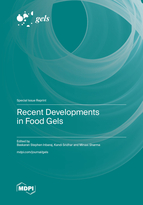Recent Developments in Food Gels
A special issue of Gels (ISSN 2310-2861). This special issue belongs to the section "Gel Applications".
Deadline for manuscript submissions: closed (20 August 2023) | Viewed by 37609
Special Issue Editors
Interests: nanoscience and nanotechnology; nanodiagnostics and nanotherapeutics; sensors; food/environmental/agricultural waste valorization; food and environmental toxins—analysis and treatment; food and environmental analytical chemistry; novel and green extraction/pretreatment techniques; chromatography—method development; pharmacokinetics and bioavailability; adsorption science and technology
Special Issues, Collections and Topics in MDPI journals
Interests: agri-food waste utilization; characterization and application of plant proteins; food processing; quality and functionality of foods; extraction of bioactive compounds; functional foods; food product development; micro/nanoencapsulation
Special Issues, Collections and Topics in MDPI journals
Interests: nanoencapsulation; functional and nutraceutical foods; essential oils; food waste valorization; microbial biotechnology; plant bioactives
Special Issues, Collections and Topics in MDPI journals
Special Issue Information
Dear Colleagues,
Gels are polymeric colloids with viscoelastic properties that can incorporate large quantities of water, air or oil within their 3D networks, lending them unique properties for broader applications. Although some existing challenges in designing gels have been overcome by major breakthroughs in synthetic polymer chemistry, emerging challenges such as source renewability, cost effectiveness and sustainability remain. Therefore, there is a compelling need for gels prepared from natural sources. Gels prepared from food biopolymers such as proteins and polysaccharides have great potential to meet these challenges because of the affordable, edible, biocompatible, biodegradable and renewable nature of their building blocks. Additionally, they possess a large variety of functionalities and physical gelation characteristics. Compared to synthetic gels, food gels play a critical role in modern food design in structuring foods with desired sensorial, rheological, textural and functional properties, preserving metastable food structures to increase shelf-life, replace fats, enhance satiety to reduce food intake, and aid in the design of complex food shapes through 3D printing. Inevitably, more critical research is necessary to unravel the gel fabrication methods, gelling mechanisms, novel design approaches and structural/mechanical properties of food gels. Furthermore, it is important to investigate how such food gel design principles alter rheological and tribological properties for food quality improvement and nutrient modification of foods without affecting the sensory properties, and how these gels may be used in targeted drug/bioactive delivery within the gastrointestinal tract.
Thus, this Special Issue on Recent Developments in Food Gels will publish research papers and review articles dealing with topics including but not limited to:
- Food gel fabrication with novel processing methods;
- Polymerization/crosslinking methods;
- Elucidation of molecular mechanisms;
- Innovative analytical approaches to characterization, molecular structure–functionality relationship;
- Food gel–body interaction.
Dr. Baskaran Stephen Inbaraj
Dr. Kandi Sridhar
Dr. Minaxi Sharma
Guest Editors
Manuscript Submission Information
Manuscripts should be submitted online at www.mdpi.com by registering and logging in to this website. Once you are registered, click here to go to the submission form. Manuscripts can be submitted until the deadline. All submissions that pass pre-check are peer-reviewed. Accepted papers will be published continuously in the journal (as soon as accepted) and will be listed together on the special issue website. Research articles, review articles as well as short communications are invited. For planned papers, a title and short abstract (about 100 words) can be sent to the Editorial Office for announcement on this website.
Submitted manuscripts should not have been published previously, nor be under consideration for publication elsewhere (except conference proceedings papers). All manuscripts are thoroughly refereed through a single-blind peer-review process. A guide for authors and other relevant information for submission of manuscripts is available on the Instructions for Authors page. Gels is an international peer-reviewed open access monthly journal published by MDPI.
Please visit the Instructions for Authors page before submitting a manuscript. The Article Processing Charge (APC) for publication in this open access journal is 2600 CHF (Swiss Francs). Submitted papers should be well formatted and use good English. Authors may use MDPI's English editing service prior to publication or during author revisions.
Keywords
- hydrogels (macrogels)/microgels/nanogels
- oleogels/aerogels/lipogels/emulgels
- multicomponent/mixed gels
- food gel networks
- natural biopolymers
- stimuli-responsive food gels
- herbal gels
- self-assembled gels
- food product development
- food fortification
- GIT uptake and release
- natural product encapsulation and delivery
Related Special Issue
- Recent Developments in Food Gels (2nd Edition) in Gels (1 article)









